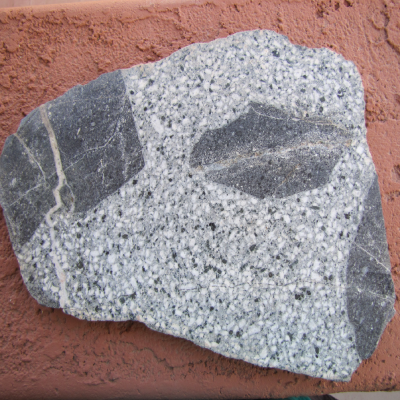
The history of the Earth is written in the rocks. It is the geologist’s job to read and interpret that history. In today’s article I provide you with the opportunity to try your hand at it.

To the right is a photo of a slab from a rock I collected near Silver City, New Mexico. The slab shows several events. Your challenge is to put those events in chronological order. Even without geological training, careful observation and logic should allow you to deduce the sequence of four of the events recorded in the rock. I’ll give you a hint to start off: there are two kinds of igneous rock in the slab and the white and grey lines are quartz veins. (You may be able to enlarge the photo by clicking on it, then click back arrow to return to the article.)
After you try your powers of deduction, scroll down the page. I reproduced the slab with six major events numbered in order. Below that, I give my interpretation of what this rock tells us.
Here is my interpretation of what the rock tells us:
The major clues are these: the dark rock is completely enclosed by the lighter rock, therefore the darker rock is older than the lighter rock. Some quartz veins cut only the dark rock, others cut both. These are the observations you can make by logic alone.
Here is the sequence as I see it:
The dark rock (1) is a volcanic rock, an andesite, and it was in place before being intruded by the lighter-colored rock, a rhyolite porphyry (2). I say this because chunks of the dark rock are enclosed in the lighter rock.
The magma that would form the light rock (2) may have been emplaced below the andesite (1) and it began to cool and crystallize. Phenocrysts (crystals) of feldspar (white) and biotite (black mica) began to form. The grey groundmass in which the phenocrysts occur did not crystallize before the rock cooled; it is called cryptocrystalline. As the magma cooled it produced the first generation of quartz veins which cut the dark andesite (3).
 Before the light rock completely cooled, there was a resurgence of magma pressure which caused the rhyolite (2) to intrude the andesite (1). This caused chunks of the dark andesite to break off and become enclosed by the rhyolite (4). You can see a chilled border (5) in the rhyolite adjacent to the black fragments, providing more evidence that the andesite preceded the rhyolite. (Okay, you probably need a hand lens to see this feature.) A chilled border is characterized by smaller phenocrysts. After this intrusion, the rhyolite cooled rapidly and stopped the crystallization process. The cryptocrystalline groundmass never finished forming crystals. Remaining volatiles in the magma formed a second generation of quartz veins (6) which cut the andesite, the rhyolite, and the earlier quartz veins. The dark spots in the second-generation quartz vein (upper left) are pyrite and chalcopyrite, sulfides of iron and copper, which typically form as the last gasp of cooling.
Before the light rock completely cooled, there was a resurgence of magma pressure which caused the rhyolite (2) to intrude the andesite (1). This caused chunks of the dark andesite to break off and become enclosed by the rhyolite (4). You can see a chilled border (5) in the rhyolite adjacent to the black fragments, providing more evidence that the andesite preceded the rhyolite. (Okay, you probably need a hand lens to see this feature.) A chilled border is characterized by smaller phenocrysts. After this intrusion, the rhyolite cooled rapidly and stopped the crystallization process. The cryptocrystalline groundmass never finished forming crystals. Remaining volatiles in the magma formed a second generation of quartz veins (6) which cut the andesite, the rhyolite, and the earlier quartz veins. The dark spots in the second-generation quartz vein (upper left) are pyrite and chalcopyrite, sulfides of iron and copper, which typically form as the last gasp of cooling.
That’s my interpretation. It is what the geologist could deduce in the field. Chemical analysis and examination with a microscope would probably add more details to the story.
So, how did you do?
